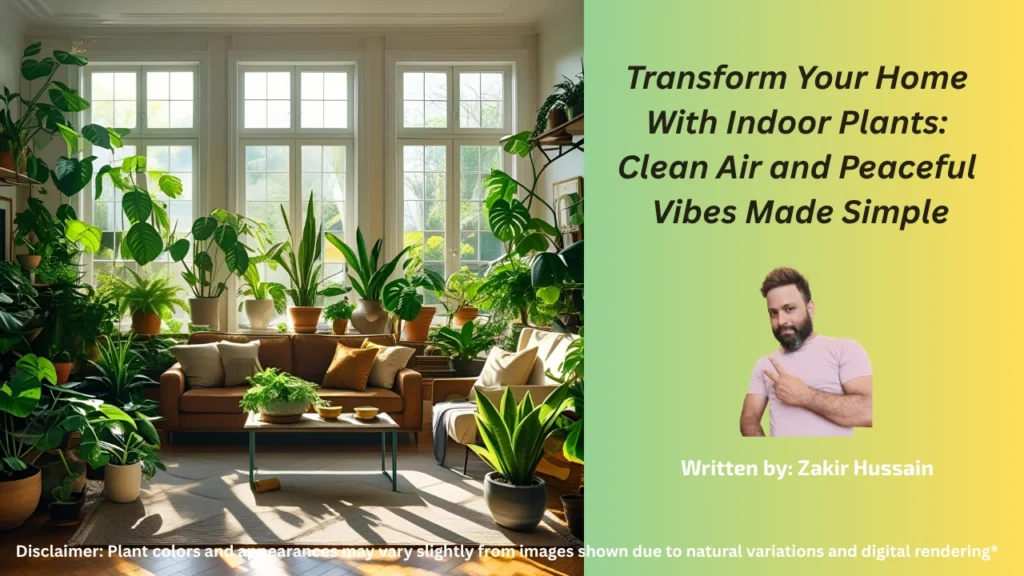Have you ever entered a room with common indoor plants and felt calmer right away? Even when you’re indoors, there’s something enchanting about being surrounded by greenery. I’ve found that the correct indoor plants do more than simply make your house seem gorgeous; they also purify your air and bring about a sense of tranquility that’s difficult to get elsewhere.
Allow me to share what I’ve discovered about selecting common indoor plants that will create a calmer, healthier haven in your home.
The Reasons Why Common Indoor Plants Can Revolutionize Your Home
You might be surprised to learn that indoor air pollution can surpass outdoor air pollution. We’re breathing in things we’d prefer not to think about, such as cleaning supplies, furniture off-gassing, and common home objects. Indoor plants can be your hidden weapon in this situation.
Certain common indoor plants are extremely excellent at filtering out harmful compounds like formaldehyde, benzene, and other pollutants, according to a study conducted by NASA (yes, NASA!). The truly amazing thing is that these houseplants do more than merely purify the air. They also naturally elevate your mood.
I’ve found that being around my indoor plants helps me feel less anxious and more grounded. There is scientific evidence to support this as well; research indicates that exposure to greenery reduces stress hormones and improves concentration. It’s similar to receiving natural therapy in the comfort of your own home.
My List of the Top 10 Common Indoor Plants for Clear Air and Positive Energy
1. Snake Plant: Best Friend of the Night Owl
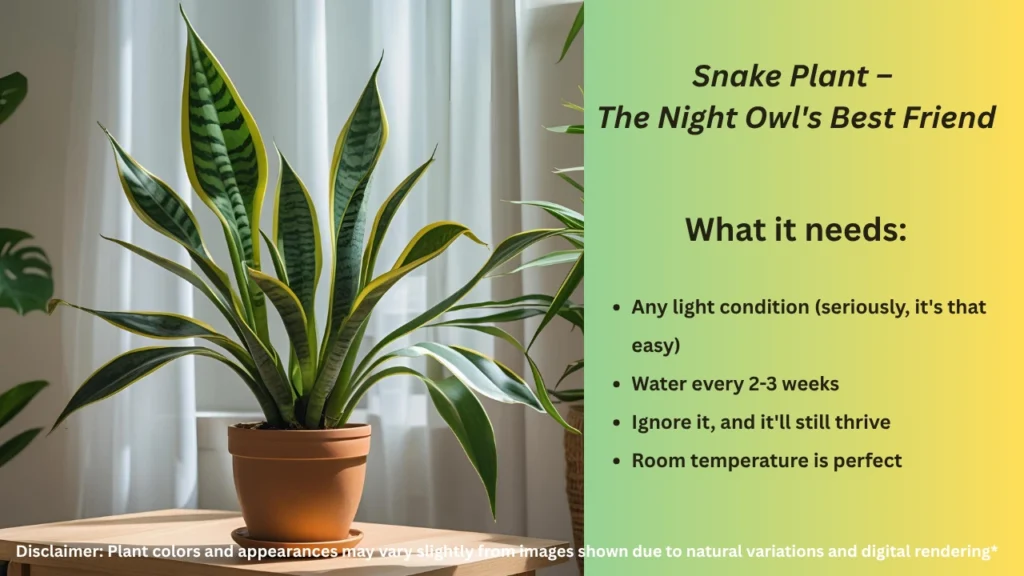
The snake plant ought to be your first choice if you’re new to indoor gardening. This one is my favorite because it’s almost indestructible and, even better, it releases oxygen as you sleep at night. Unlike other plants, this gem does the reverse.
I have one in my bedroom, and the towering, sculptured leaves give the room a contemporary, peaceful feel. Additionally, it’s putting forth extra effort to filter the air of formaldehyde.
What it requires:
- Any light condition (seriously, it’s that easy)
- Water every 2-3 weeks
- Ignore it, and it’ll still thrive
- Room temperature is perfect
2. The Dramatic Beauty of Peace Lily
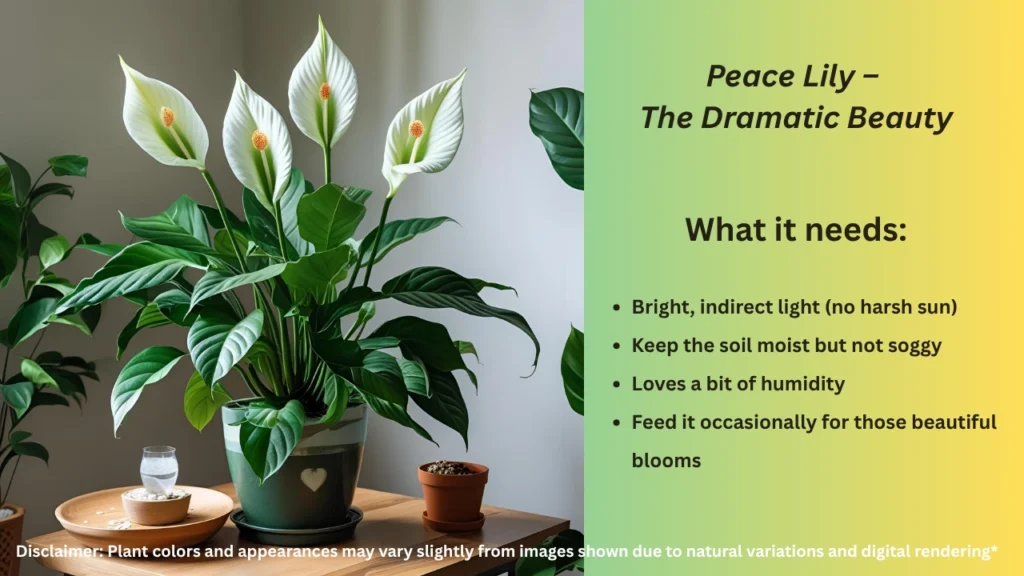
Beautiful indoor plants with graceful white blooms that seem to belong in a spa are peace lilies. Every time someone comes to visit, people remark on how calm the place feels because of mine, which is in my living room.
I adore peace lilies since they are aesthetically pleasing and function similarly to a personal air cleaner. They eliminate formaldehyde, benzene, and ammonia. Additionally, you won’t have to guess when they need water because they will actually droop!
What it requires:
- Light that is bright and indirect (no strong sun)
- Don’t let the soil get too wet.
- enjoys a little humidity
- Sometimes feed it to get those lovely blossoms.
3. Spider Plant: The Everlasting Present

The indoor plants that first sparked my interest in gardening were spider plants. They are incredibly giving; they continue to produce baby plants that you can give to friends or add to your own collection. I now have five after starting with just one!
These happy houseplants have a wonderful cascading effect that softens any space and are excellent at eliminating formaldehyde and xylene from the air.
What it requires:
- The best light is bright, indirect light.
- When the top soil seems dry, water it.
- Normal room humidity is OK.
- Keep an eye out for those cute baby plants!
4. Rubber Tree: The Expression
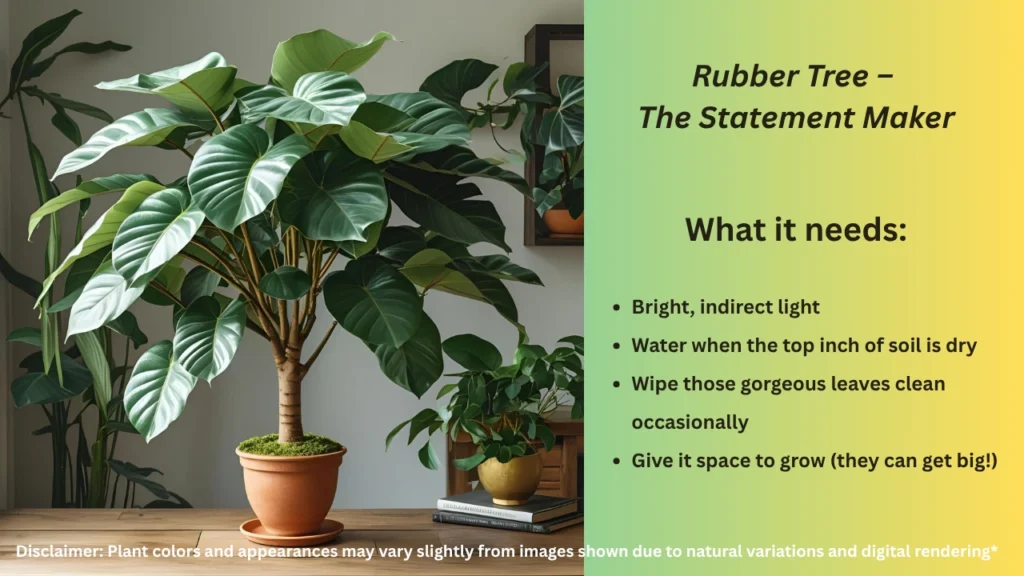
Rubber trees are the solution if you want common indoor plants that have a noticeable effect. It has grown to be a stunning focal point in my home office and is currently around four feet tall. In addition to being beautiful, the glossy leaves are subtly eliminating formaldehyde from the atmosphere.
What it requires:
- Indirect, bright light
- When the top inch of soil is dry, water it.
- Every now and again, wipe those beautiful leaves clean.
- Allow room for growth—they can get quite large!
5. Boston Fern: The Hero of Humidity
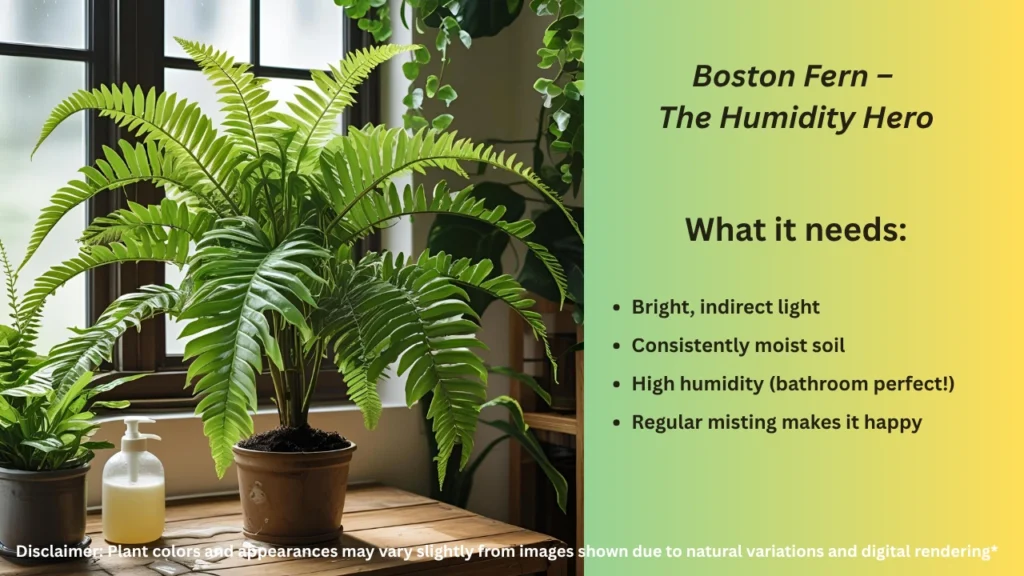
The thick, feathery indoor Boston ferns instantly transform any area into a tropical haven. It’s fantastic for eliminating formaldehyde and adding moisture to dry air, and I keep mine in the bathroom where it enjoys the humidity from showers.
What it requires:
- Indirect, bright light
- Regularly wet soil
- High humidity—perfect for a bathroom!
- It is happy when it is regularly misted.
6. Aloe Vera: The Multipurpose Plant
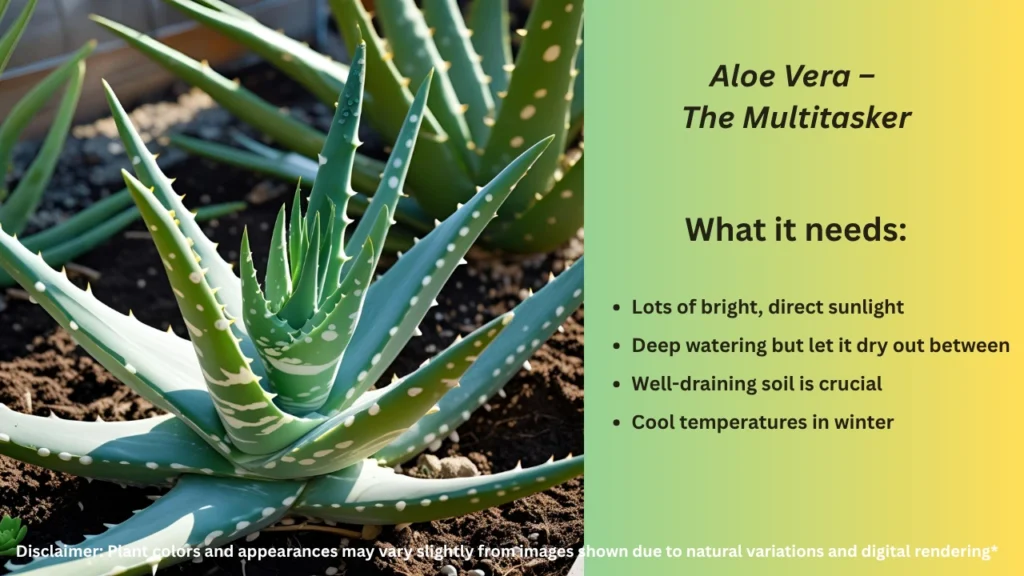
Aloe vera is a natural first aid kit in addition to being one of the most useful houseplants. It works continuously to eliminate formaldehyde and benzene from the air, and I keep mine on my kitchen windowsill where it receives lots of sunlight.
In addition, I just break off a piece for immediate comfort when I inadvertently burn myself while cooking. It’s similar to having a drugstore that also purifies your air.
What it requires:
- A lot of direct, bright sunshine
- Water deeply, but let it to dry out in between
- Soil with good drainage is essential.
- Cool winter temperatures
7. Pothos: The Relaxed Mainstay
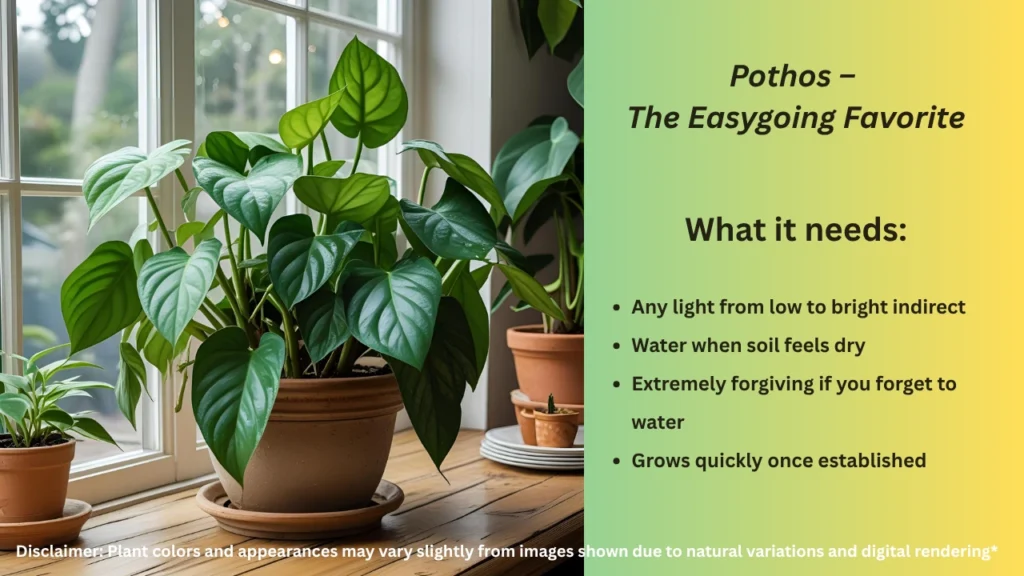
You won’t find many more tolerant indoor plants than pothos. I have them hanging in baskets, crawling up poles, and trailing from shelves all throughout my house. They are reliable tools for eliminating benzene, toluene, and formaldehyde.
Their versatility is what I adore most about them; I have some in sunny areas and others in shadier areas, yet they all flourish.
What it requires:
- Any indirect light, from dim to bright
- When the soil feels dry, water it.
- Very understanding if you neglect to water
- Once established, it grows rapidly.
8. Chinese Evergreen: The Champion of Low Light
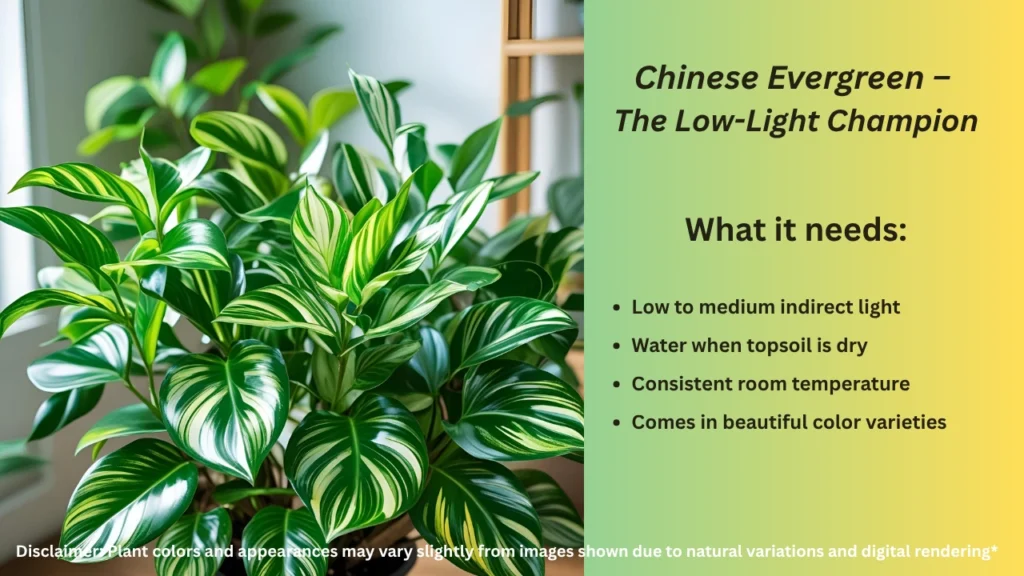
Chinese evergreens are ideal for those shadier areas where other indoor plants have trouble growing. Even though mine receives very little natural light, its vibrant, patterned leaves continue to look stunning while filtering benzene and formaldehyde.
What it requires:
- Indirect light that is low to medium
- When the topsoil is dry, water it.
- Maintaining a steady room temperature
- comes in a variety of lovely colors.
9. Dracaena: The Accent in Vertical Form
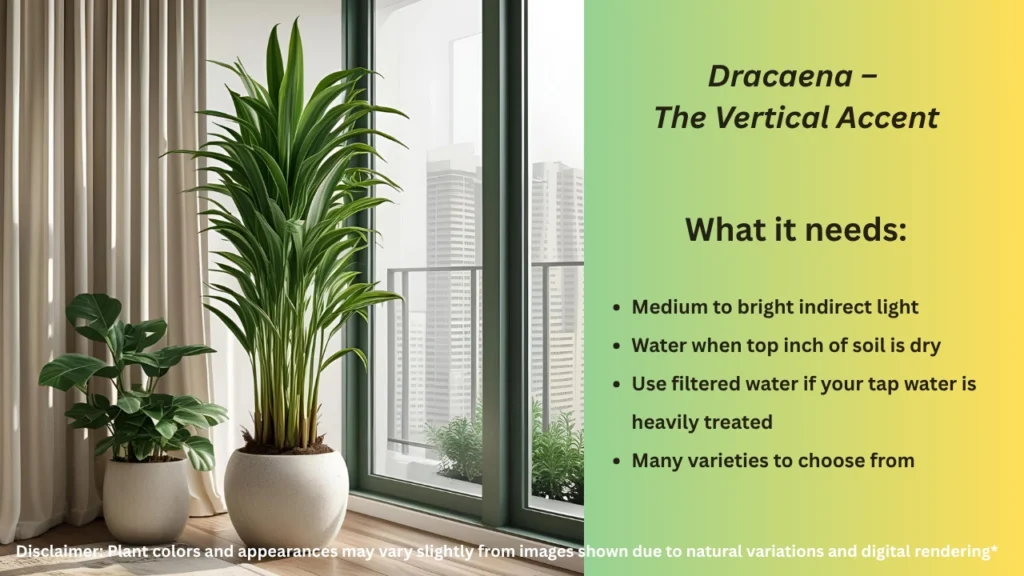
The indoor plants I suggest when you want to give a room height and drama are dracaenas. They are excellent in eliminating formaldehyde, benzene, and trichloroethylene, and their brilliant, spiky leaves produce these lovely vertical lines.
What it requires:
- Indirect light that is moderately bright
- When the top inch of soil dries, water.
- If your tap water is excessively treated, use filtered water.
- Numerous types to select from
10. ZZ Plant: The Dream of the Traveler
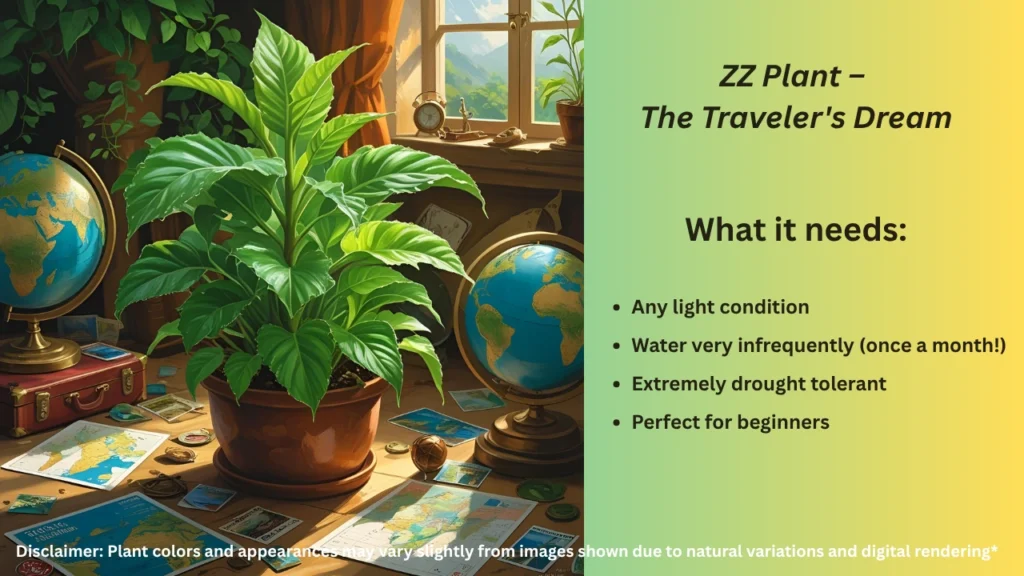
ZZ plants are ideal if you travel frequently or simply want extremely low-maintenance indoor plants. It looked flawless even though I had neglected to water it for a whole month. In the meantime, it is silently eliminating xylene and toluene from the atmosphere.
What it requires:
- Any light condition
- Water very infrequently (once a month!)
- Extremely drought tolerant
- Perfect for beginners
How to Create Your Own Garden Sanctuary
Where to Plant These Common Indoor Plants
I’ve found that when it comes to common indoor plants, their position is very important. Plants like pothos make beautiful natural curtains, but I prefer to place taller plants like rubber trees in corners to anchor the area. Mixing indoor plants creates a lush, jungle-like atmosphere in the space that is quite relaxing.
The Allure of Green Therapy
In fact, caring for indoor plants is almost therapeutic. Every week, I water, rotate, and spend time with my green friends as part of this mindful habit. It’s incredible how centered and peaceful this simple habit can make you feel.
Adapting it to your lifestyle
Choosing common indoor plants to suit your lifestyle is essential to their success. If you are busy, choose low-maintenance plants like the ZZ plant and snake plant. If you like routine, Boston ferns and peace lilies may be ideal for you.
Keeping your houseplants satisfied
Easy care tips
I have made it a Sunday morning ritual to check on my indoor plants once a week. I check for any problems, rotate them to ensure even growth, and simply enjoy their company. I now look forward to this weekly interaction as one of my favorite things to do.
Learning from mistakes
Over the years, I’ve killed a fair number of common indoor plants, and I’ve found that the main killer is overwatering. Most indoor plants like to go a little dry between waterings. If you’re unsure, wait another day or two.
Seasonal changes
As the seasons change, your common indoor plants will require different maintenance. I don’t fertilize at all in the winter and water less frequently. I may repot or fertilize them in the spring, when they wake up and start growing again.
How many common indoor plants are necessary?
To be honest, I keep adding indoor plants until my home feels just right, even though NASA recommends one air-purifying plant per 100 square feet. I keep them in my living room, home office, and bedroom, where I spend the most time.
Your indoor plant adventure starts now
The best thing I’ve ever done for my home and my health is adding these common indoor plants. Besides providing a vitality and energy that no fake decor can match, these living air purifiers work around the clock to make spaces cleaner and more peaceful.
Instead of starting with a jungle, choose one or two houseplants that you love and see how they transform your room. When you see how many amazing benefits these eco-friendly friends add to your everyday life, I promise you’ll want to plant even more.
Your common indoor plants will give you cleaner air, happier moods, and a more inviting home, whether you choose the dramatic Peace Lily or the indestructible Snake Plant. Once you start bringing nature indoors, you’ll question how you ever survived without these incredible indoor plants.
